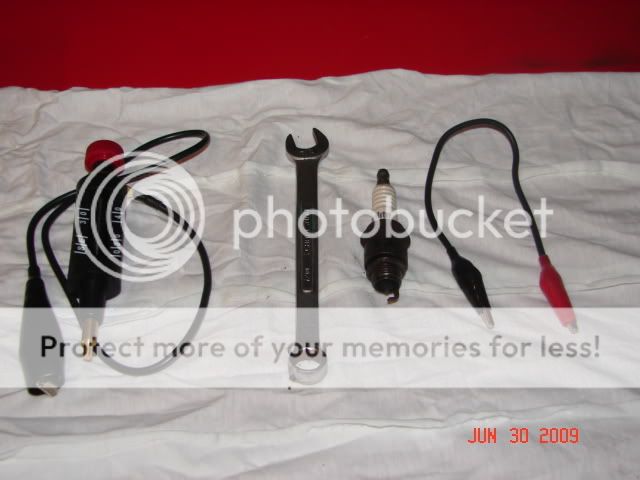(quoted from post at 15:56:40 10/29/14) Using Stabil & a battery tender is wise.
Make sure the battery is fully charged before you go looking for the problem.
Next, check out tip #39 at the link. If you own a 60+ year old tractor, you need the manuals.
It takes three things for an engine to run: spark at the right time, compression, & fuel/air in the right mixture. For the moment, forget about compression & concentrate on narrowing the problem down to spark or fuel.
There are three very important tools you always need to have in your N tool box: a 3 inch piece of wire w/ alligator clips on each end, a spark checker w/ an adjustable gap (* see below) and a 7/16 box end wrench. (see tip # 50 at the link below) And, you really do need a working ammeter on the tractor; it is a very important diagnostic tool. With these tools, you can quickly narrow down most N problems to spark or fuel.
First, check for fuel. Get a can & put it under the carb. Remove the bolt in the bottom of the carb; as long as the fuel is turned on, you should see gas flowing out of the carb. Let it run for at least 30 seconds. If it’s a dribble, or runs for 5 seconds & stops, or none at all, you have solved half the problem: it’s fuel related. If gas flows well out of the carb & only stops when you turn it off at the sediment bowl, chances are very good it’s not a fuel problem. So, next, turn the key on, crank the engine & look at the ammeter. What is the needle doing? Does it show a constant discharge, no movement at all, or does it move back & forth slightly? Next, hook up your spark checker, turn the key on & crank the engine. If the spark jumps the 1/4” gap, you probably don’t have a spark problem. If it won’t jump the ¼” gap, you have a spark problem. If the ammeter needle shows a constant discharge, or doesn’t move at all, that also tells you that you have a spark problem. Jump the ignition switch w/ your jumper wire & see what happens. If it runs, you found the problem. If it doesn’t have spark after you jump the ignition switch, post back for more info on further troubleshooting. (and do not forget to turn the ignition switch off; see tip # 38)
If it does not have gas coming out of the carb at a steady stream w/ the bolt out for at least 30 seconds, you have a fuel problem. First, remove the gas cap. Your vent could be clogged & it vacuum locked. If that doesn’t work, tap the carb bowl w/ a hammer handle in case the float is sticking closed. (don’t whack it w/ the head of the hammer; you can crack the bowl). If you still don’t see gas flowing, the N has three fuel screens; one in the brass elbow, one in the top of the sediment bowl & one on the stem of the sediment bowl in the gas tank. Check the screen in the elbow & the screen in the top of the sediment bowl. (don’t worry about the one in the tank) Both probably need to be cleaned. If you have the fuel knob turned on all the way, & 1 gallon or less in the tank, it may be trying to feed off of the reserve inlet which is probably clogged. Only open it 2 full turns. Put at least 2 gallons in the tank. (and do not forget to turn the gas off; see tip # 9)
There are ways to check for spark & fuel that work & ways that don't. For example, having gas to the carb is nice, but having it past the float is what counts! That’s why removing the 7/16” bolt in the bottom of the carb is the way to check for fuel. And, same thing w/ spark at the plugs. Some folks think that checking for spark means pulling a plug wire off & looking for one. Well, it's the distance the spark jumps at the plug that gives you the info you want. It takes about 17kv to jump a 3/16" gap & 22kv to jump ¼” in the open air. Remember, it’s 14psi outside of the engine & about 90psi at a 6:1 compression ratio in the cylinders & compressed air creates electrical resistance, so you really need the 17-22kv to fire the plugs when the engine is running. A store bought plug checker (in the picture) will work better than an old plug because it won’t shock the snot out of you like an old plug might!
Chances are about 7 out of 10 that your points are corroded from sitting all winter. But, lets not guess; confirm you have a spark problem & that it's in the distributor before you jump ahead to fixing it.
Post back with results or more questions.
*If you don’t own a spark checker w/ an adjustable gap, buy one. In the meantime, an old spark plug w/ the gap opened to at least ¼” will work. Ground it to a rust & paint free spot on the engine turn the key on & look for a spark.
75 Tips[/url
Thanks Bruce. Lots to learn here. Last year I had replaced fuel line and sediment bowl. Will start with charge in battery and go from there.


